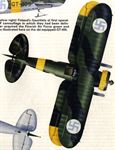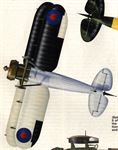Фотографии
-
Регистрационный номер: J-21 In the markings of the Danish Haerens Flyvertropper (Army Aviation Troops), this Gauntlet had been built as the first production Mk 1 for the RAF and was later supplied to Denmark as a pattern aircraft for licence production.
Самолёты на фотографии: Gloster Gauntlet - Великобритания - 1929
-
Регистрационный номер: K5272 A Gauntlet II, K5272, of No 111 Squadron, RAF, at Northolt in March 1937. Black bar on the fuselage, repeated across the upper wing between the roundels, was the squadron marking, whereas black fin signified a flight leader's aircraft.
Самолёты на фотографии: Gloster Gauntlet - Великобритания - 1929
-
Регистрационный номер: K7890 Gauntlet II K7890 was on the strength of No 151 Squadron, RAF, at North Weald in 1937. The squadron marking was a narrow black bar centred on a broad pale blue bar, and was repeated on the wing upper surface.
Самолёты на фотографии: Gloster Gauntlet - Великобритания - 1929
-
A Danish-built Gauntlet of 1 Eskadrille, Haerens Flyvertropper at Vaerlose in early 1940. The camouflage colours had been adopted in 1939, with greenish yellow and dark greyish green on the upper surfaces and light grey-blue underside.
Самолёты на фотографии: Gloster Gauntlet - Великобритания - 1929
-
Регистрационный номер: K7843 Gauntlet II K7843 of No 3 Squadron, RAAF, at Helwan in Egypt, November 1940. This squadron flew a number of dive-bombing operations with its Gauntlets for a few days in December 1940.
Самолёты на фотографии: Gloster Gauntlet - Великобритания - 1929
-
Регистрационный номер: GT-405 Finland's Gauntlets at first operated in the RAF camouflage in which they had been delivered, but later acquired the Finnish Air Force green and black finish, as illustrated here on the ski-equipped GT-405.
Самолёты на фотографии: Gloster Gauntlet - Великобритания - 1929
-
Side view of a Gauntlet II of No 17 Squadron at Kenley in late 1938, after the Munich crisis had brought the hasty application of camouflage, obliteration of serial numbers
Самолёты на фотографии: Gloster Gauntlet - Великобритания - 1929
-
Finland's Gauntlets at first operated in the RAF camouflage in which they had been delivered, but later acquired the Finnish Air Force green and black finish, as illustrated here on the ski-equipped GT-405.
Самолёты на фотографии: Gloster Gauntlet - Великобритания - 1929
-
Plan view of a Gauntlet II of No 17 Squadron at Kenley in late 1938, after the Munich crisis had brought the hasty application of camouflage, obliteration of serial numbers
Самолёты на фотографии: Gloster Gauntlet - Великобритания - 1929








